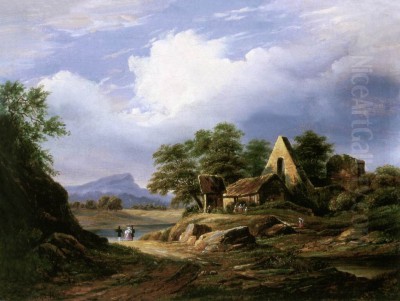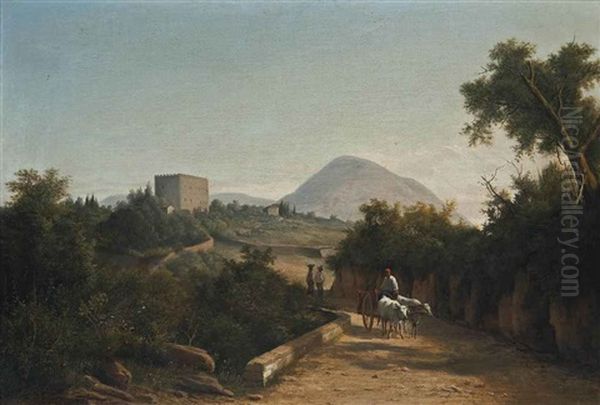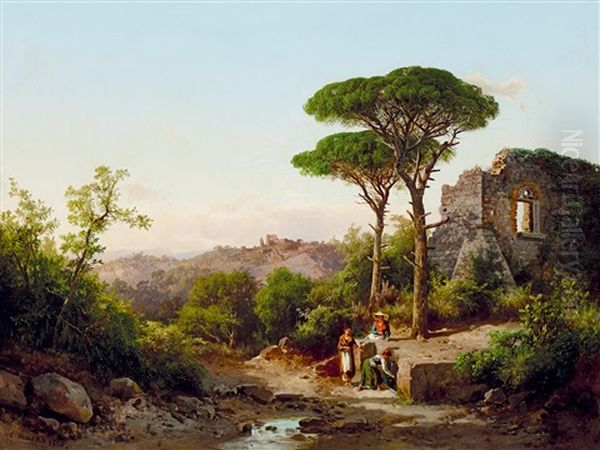
Károly Markó the Younger, born in 1822 and passing away in 1891, occupies a specific niche within the grand tapestry of 19th-century European art. As a painter primarily dedicated to landscape, he navigated the currents of Romanticism, following in the significant footsteps of his renowned father. While perhaps less internationally celebrated than his progenitor, his work offers valuable insights into the continuation and evolution of landscape painting traditions, particularly those focused on the enduring allure of the Italian countryside, during a period of significant artistic change across the continent.
His life spanned a dynamic era, witnessing the flourishing of Romanticism, the rise of Realism, and the revolutionary emergence of Impressionism and Post-Impressionism. Understanding his art requires acknowledging both the powerful legacy he inherited and the specific artistic choices he made within his historical context. He was a conduit for a particular style, one deeply rooted in careful observation of nature combined with an idealized, often pastoral, sensibility.
The Markó Dynasty: A Father's Shadow and Influence
It is impossible to discuss Károly Markó the Younger without first acknowledging his father, Károly Markó the Elder (1791–1860). The Elder Markó was a seminal figure in Hungarian art history, widely regarded as one of the country's most important landscape painters. Initially trained as an engineer, he turned to art, studying in Pest and later, significantly, at the Vienna Academy of Fine Arts. His work, often characterized by meticulous detail, classical compositions, and idyllic, light-filled scenes inspired by masters like Claude Lorrain, earned him considerable acclaim.
Markó the Elder spent a significant portion of his career in Italy, particularly in Florence and the surrounding Tuscan countryside, eventually settling near Florence at the Villa Appeggi. His Italian landscapes, often populated with mythological or biblical figures, became highly sought after. He established a standard for idealized landscape painting that blended Neoclassical structure with Romantic sensitivity to light and atmosphere. This was the environment Károly Markó the Younger was born into – one steeped in artistic practice and centered around the success of his father.

Growing up under the tutelage and influence of such a prominent artist undoubtedly shaped the Younger Markó's path. He received his initial training directly from his father, absorbing the techniques and thematic preoccupations that defined the Markó style. This familial connection provided both an invaluable education and, potentially, the challenge of forging his own artistic identity while bearing a famous name. The distinction between father and son is crucial, as their works can sometimes be confused, though stylistic nuances often differentiate them.
Artistic Formation and the Italian Draw
While specific details about Károly Markó the Younger's formal education beyond his father's instruction are less documented than his father's time in Vienna, it is evident that he embraced the family tradition. Like his father, he was profoundly drawn to Italy. The Italian peninsula, with its dramatic landscapes, ancient ruins, luminous quality of light, and deep association with the classical past and the Grand Tour, held an irresistible appeal for generations of European artists.
He spent considerable time working in Italy, continuing the family's connection to the region. This immersion in the Italian environment is reflected in the subject matter of many of his known works. He painted the rolling hills, picturesque villages, winding country roads, and atmospheric conditions that had captivated his father and countless artists before him, from the aforementioned Claude Lorrain to contemporaries who made the pilgrimage south.
His approach, while clearly indebted to his father's style, sometimes exhibits subtle differences. Art historians occasionally note a slightly looser handling or a more naturalistic feel in the Younger's work compared to the Elder's often highly polished, almost crystalline finish. However, he remained firmly within the bounds of the Romantic landscape tradition, focusing on harmonious compositions, evocative light, and scenes that often conveyed a sense of peace and timelessness.
Style and Thematic Focus: Romanticism Continued
Károly Markó the Younger's primary artistic mode was Romantic landscape painting. This broad movement emphasized emotion, individualism, the power and beauty of nature, and often a nostalgic longing for the past or for simpler, pastoral ways of life. His work aligns well with the picturesque vein of Romanticism, focusing on scenes that are pleasing, well-composed, and imbued with a gentle, often sentimental, atmosphere.
His landscapes typically feature elements common to the genre: carefully rendered trees and foliage, bodies of water reflecting the sky, distant mountains fading into atmospheric haze, and often small human or animal figures that serve to animate the scene and provide scale. These figures – travelers, shepherds, peasants, or elegantly dressed young women – rarely dominate the composition but rather inhabit the landscape, suggesting a harmonious relationship between humanity and nature.

Unlike the more turbulent or sublime aspects of Romanticism seen in the works of artists like J.M.W. Turner or Caspar David Friedrich, Markó the Younger's paintings generally evoke tranquility. His use of light is crucial, often depicting the warm glow of morning or late afternoon, casting long shadows and highlighting textures. The compositions are typically balanced and carefully constructed, drawing the viewer's eye into the scene along winding paths or rivers.
Representative Works and Known Oeuvre
Several works help illustrate Károly Markó the Younger's artistic output. One frequently cited painting is Romantic Landscape with young girls. The title itself signals his adherence to the Romantic sensibility. While details of this specific painting might vary across different versions or similarly titled pieces, it likely depicts an idyllic natural setting populated by graceful female figures, embodying themes of youth, beauty, and harmony with nature. A version of this subject, measuring 61 x 47 cm, was noted as being auctioned in good condition, bearing a signature and exhibition label, indicating its circulation and recognition within the art market.
Another known title is The Traveler on the Italian Country Road (or The Traveler in the Italian Countryside). This theme was a staple of landscape painting, allowing the artist to explore the picturesque qualities of rural Italy – dusty roads, stone pines, distant villas or villages, perhaps under a clear Mediterranean sky. The lone traveler often served as a focal point, inviting contemplation about journeys, solitude, or the experience of discovering foreign lands.
A significant work mentioned is a large Italian panorama created in 1879. Described as featuring shepherds, goats, and a village in the background, and deemed of "museum quality," this suggests a major, ambitious composition undertaken later in his career. Such panoramic views were popular in the 19th century, offering expansive vistas that showcased the artist's skill in rendering depth, detail, and atmospheric perspective across a wide scope. Its existence points to his continued activity and ambition well into the latter half of the century.
Context within 19th-Century Landscape Painting
To fully appreciate Károly Markó the Younger's contribution, it's helpful to place him within the broader context of European landscape painting. He worked during a period when landscape transitioned from being considered a lower genre to achieving parity with historical and portrait painting. His father was part of this elevation, particularly within Central Europe.
The Younger Markó continued a tradition deeply influenced by 17th-century masters like Claude Lorrain and Jacob van Ruisdael, whose idealized or dramatic natural scenes set precedents. He was also a contemporary of the Barbizon School painters in France, such as Camille Corot and Théodore Rousseau, who emphasized direct observation of nature and plein-air sketching, though their finished works often retained a studio polish and sometimes idealized elements. While Markó's style remained more aligned with the Italianate tradition, the Barbizon focus on naturalism was shifting landscape painting across Europe.
In Britain, the legacy of John Constable, with his fresh, empirical studies of the English countryside, and J.M.W. Turner, with his visionary explorations of light and atmosphere, had already pushed the boundaries of landscape. In Germany, the spiritual and symbolic landscapes of Caspar David Friedrich represented a different facet of Romanticism. Markó the Younger's work appears less radical than these figures, representing a more conservative continuation of established landscape conventions.
Within Hungary, landscape painting was developing its own identity. While Markó the Elder was a foundational figure, other artists like Miklós Barabás (also known for portraits) and Soma Orlai Petrich contributed to the national school. Later in the century, Mihály Munkácsy would gain international fame, though primarily for his dramatic genre scenes and large-scale historical paintings rather than pure landscapes in the Markó tradition. Markó the Younger fits into this Hungarian context as a carrier of his father's specific, internationally oriented, Italianate landscape style.
Artistic Practice and Reception
Like most landscape painters of his era, Károly Markó the Younger likely employed a combination of outdoor sketching and studio work. Sketches made directly from nature would capture specific light effects, topographical details, and compositional ideas. These studies would then inform larger, more elaborate paintings completed in the studio, where elements could be refined, idealized, and combined to create the final harmonious composition.
His technique involved careful drawing, smooth application of oil paint, attention to detail in foliage and foreground elements, and skillful rendering of atmospheric perspective to create a sense of depth. The presence of signatures and exhibition labels on surviving works indicates that he actively participated in the art world, exhibiting and selling his paintings.
However, information regarding his specific exhibition history, critical reception during his lifetime, or membership in artistic societies is not as readily available as for his father or for the leading figures of Western European art movements. His legacy seems primarily tied to his continuation of his father's style and his competent, often charming, depictions of Romantic landscapes, particularly those set in Italy. He catered to a taste for idyllic, picturesque scenes that remained popular throughout much of the 19th century.
Navigating Artistic Shifts: Romanticism's Long Twilight
Károly Markó the Younger's career extended into a period when the art world was undergoing profound transformations. The rise of Realism, championed by artists like Gustave Courbet in France, challenged the idealized visions of Romanticism by focusing on the unvarnished depiction of contemporary life and landscapes. Courbet's earthy, robust scenes stood in stark contrast to the delicate refinement of Markó's Italianate views.
Even more dramatically, the latter part of Markó's life saw the emergence of Impressionism. Artists like Claude Monet, Pierre-Auguste Renoir, and Edgar Degas revolutionized painting with their focus on capturing fleeting moments, the effects of light and color, and scenes of modern life, often using broken brushwork and a brighter palette. Their approach was fundamentally different from the detailed rendering and structured compositions of the tradition Markó represented.
There is little evidence to suggest that Markó the Younger significantly altered his style in response to these new movements. He appears to have remained committed to the Romantic landscape aesthetic he learned from his father, an aesthetic that continued to find patrons even as avant-garde styles gained momentum. His work thus represents the persistence of older traditions alongside the birth of modern art.
Legacy and Conclusion
Károly Markó the Younger's place in art history is intertwined with that of his father. He was a skilled practitioner of Romantic landscape painting, extending the Markó family's specialty in idyllic, often Italian-inspired scenes into the later 19th century. His works are characterized by competent technique, harmonious compositions, and a gentle, picturesque sensibility.
While he may not have been an innovator on the scale of a Turner, Constable, or Monet, his paintings provide fine examples of a particular type of landscape art that held sway for much of the century. He successfully carried forward the artistic lineage established by Károly Markó the Elder, contributing his own body of work to the Hungarian and broader European tradition of landscape painting.
His art serves as a reminder of the enduring appeal of the idealized landscape, particularly the lure of Italy, for both artists and collectors. Studying his work allows us to appreciate the nuances within the Romantic movement and the ways in which artistic styles could be passed down, adapted, and sustained even amidst periods of radical change. Károly Markó the Younger remains a notable figure, representing the continuation of a significant artistic tradition through dedicated practice and a clear affinity for the beauty of the natural world as seen through a Romantic lens. His paintings, like Romantic Landscape with young girls and The Traveler on the Italian Country Road, offer windows into a serene, beautifully ordered vision of nature that resonated deeply within the 19th-century imagination.